reddit what to do about co-worker leaving early all the time
"Wait...Yous're leaving, too?"
I still call up how surprised my coworker and I were to discover that nosotros were both leaving the company within days of each other. And without e'er having talked near it.
Years later, I've met many friends who have been on both sides of employee turnover waves. I've learned they're e'er challenging for teams, their leaders, and the company as a whole– and plush.
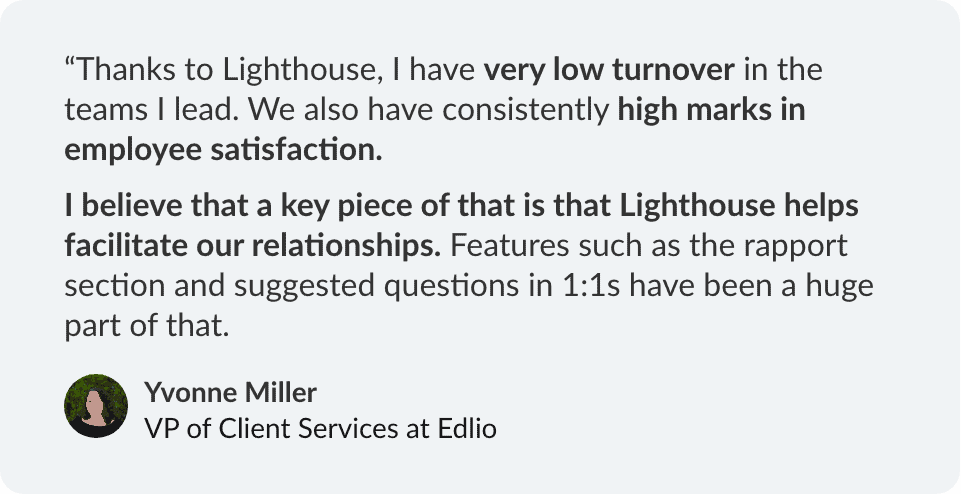
The high cost of employee turnover
Losing a single employee can cost tens of thousands of dollars. If yous're replacing an engineer, that tin can price you more than $100,000 for a unmarried employee. And a moving ridge of employee turnover tin quickly run up costs ranging into the hundreds of thousands– or more. Talk well-nigh a big striking.
Even just finding a replacement adds upwardly fast. According to a written report published past the Society for Human being Resources Direction, when an employee leaves, it costs an boilerplate of half-dozen-nine months of your former employee'due south salary to identify and onboard their replacement.
Can you afford that kind of striking financially or to productivity? Yet, it often happens to leaders, causing employee turnover rates for some companies to spike as high as 30-40% annually.
To understand how to stop a wave of departures from happening, you first need to understand why waves happen in the beginning place.
Tabular array of Contents:
- Why Your Employees Get out in Waves
- We're social creatures.
- The grass is always greener...
- Friends are a double-edged sword.
- Their departure is a wake-upwardly call.
- Momentum takes fourth dimension to build and time to stop.
- How to Stop an Employee Turnover Moving ridge
- Assume everyone is leaving and interviewing.
- Accept that what yous're doing now isn't working.
- Accept open up, honest, lengthy ane-on-ones.
- Mind & prove empathy.
- Follow through & have action.

Why Your Employees Leave in Waves
While every team and company is unique in some means, at that place are a few patterns that agree true across all companies. In our time helping leaders over the terminal vi years, and looking at the latest inquiry, we've found a few of those patterns:
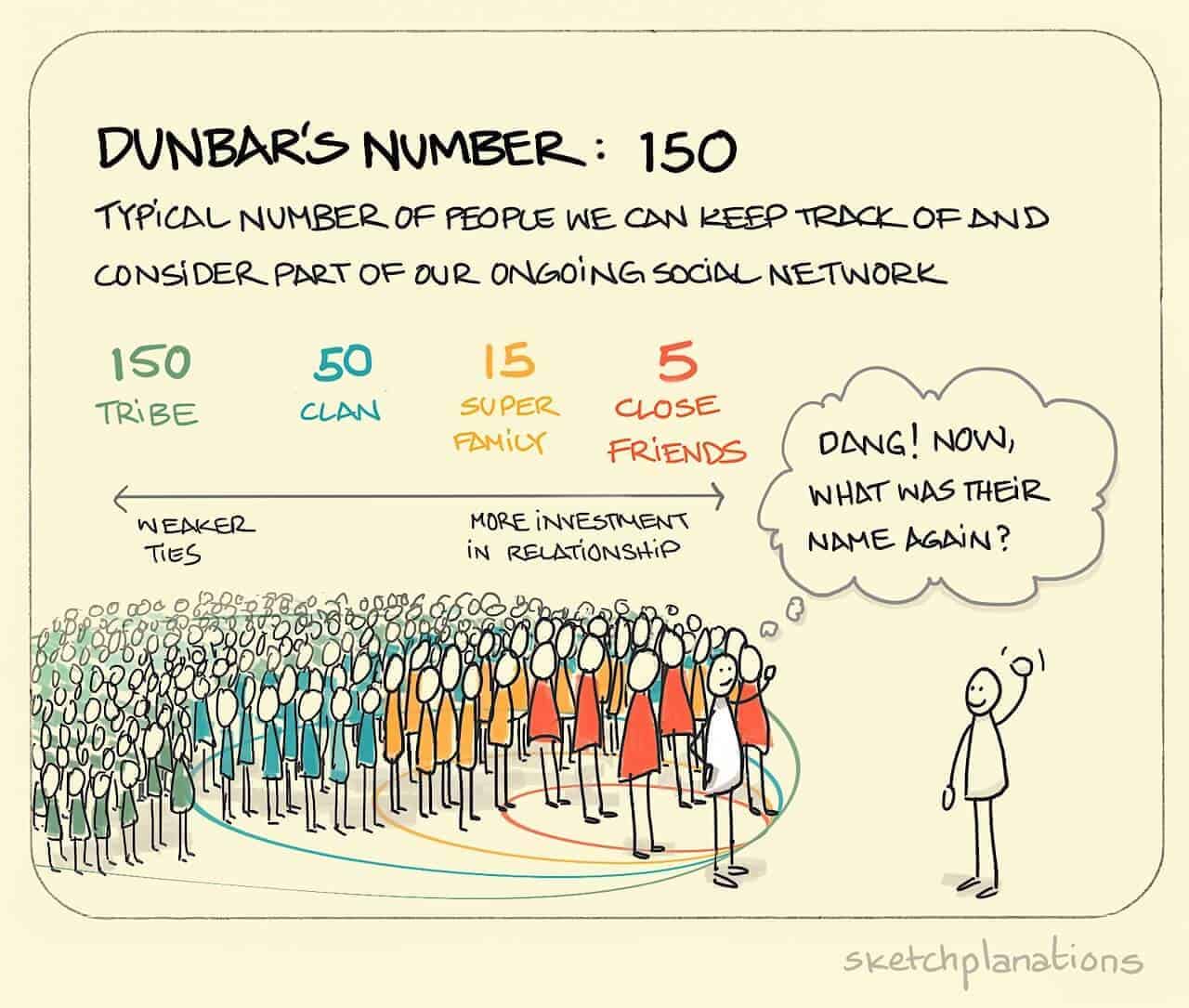
1) We're social creatures.
Researcher Robin Dunbar (famous for Dunbar'southward number) theorizes that the chief reason humans have such large brains is to manage complex social relationships in a community.
Work is one such community, consummate with politics, drama, alliances, and social norms. As social creatures, we talk near the good, the bad, and each other.
If one person on your team perceives a problem, chances are others feel it and have talked near information technology, too. Whatever is bugging one person is usually bugging others; they just haven't told anyone yet (or yous missed the signs). Over time, bug build on ane another enough to lead to people considering leaving.
For example, a friend of mine runs a x-person startup. Each month he surveys his team on a variety of questions about how he'due south doing, things going on in the company, and then on. When he reads the anonymous answers, he will often have that feedback and ask his squad about it.
To his continued surprise, nigh everyone on the team has thoughts on the feedback. And whoever wrote the feedback isn't the person he thought. When he addresses the issue, he knows he's fixing something that everyone will capeesh.
Takeaway: Whatever upshot(s) acquired someone to want to look for another chore is probably beingness experienced by others on your team as well.

two) The grass is always greener...
When you lot're being recruited, a company highlights all the awesome things about the task and the company. They too exercise their all-time to hide any less-than-desirable aspects.
You lot've probably washed this yourself when recruiting. After all, we all want to put our best pes forward.
Unfortunately, when you lot're frustrated at your current job, this gives any new job y'all're scouting more than highly-seasoned than it really is. Most companies are dysfunctional in their own unique ways, so what was wrong at one chore volition not be a problem at the next.
All the same, every company has issues. Issues you'll only learn most weeks or months after you lot bring together.
Anyone on your squad that is interviewing for other jobs is hearing the greener grass pitch. Compounding things, a person leaving the company volition likely talk excitedly about their new chore to their friends.
Fifty-fifty if you keep them from giving a 2-week notice, they'll still likely exist in touch on with colleagues who will hear how corking the new identify is over drinks, email, or social.
Takeaway: Once people are looking, they'll be enchanted past the attractive pitches they're receiving and discussion volition spread to their coworkers.

3) Friends are a double-edged sword.
It's swell when people recruit a friend to your visitor or team. It saves y'all a lot of coin and time sifting through strange resumes and questioning if they're a culture fit.
I've seen many companies hire whole groups of people who accept worked together for years and are friends both personally and professionally. It can be a huge win as they already know how to piece of work well together and have smashing team chemistry.
But therein lies the double-edged sword: when one of them leaves your visitor, their friends will likely follow.
I was recently getting brunch with a friend. Nosotros'll telephone call him Jeff. Jeff left the visitor I first met him at to join a startup along with his good friend.
Unfortunately, Jeff'due south friend got in a major, ongoing statement with his manager and left the company over information technology. Jeff lamented to me how much he missed working with his friend and seemed to be considering leaving.
A few weeks later on, by random take a chance, I was walking downwardly the street and someone from the startup Jeff was at struck up a chat with me. When I mentioned I knew Jeff worked at that place, I found out he had actually just left. The double-edged sword struck once again.
Takeaway: If people recruit their friends to your company, they're also likely to draw them away when they go out.
4) Their deviation is a wake-upwardly telephone call.
Even if an employee isn't shut friends with the person leaving, information technology can be a wake-up call to them and everyone else in the company.
They may ask themselves, "If they're leaving, maybe I should likewise," or, "If he got that kind of offer, I wonder what I could go?" This means that even people that weren't at risk tin can go a risk just out of curiosity or the fear that, "the rats are leaving a sinking transport."
It's easy for employees to become ready in their ways and put up with a tough situation. They tin can be comfy at your company for any number of reasons and finally seeing someone do something dramatic (like interviewing somewhere else or leaving) tin can brand them re-evaluate what they're doing.
Depending on how the person'south departure is handled, it can as well generate stiff feelings. The truthful colors of a company'southward leadership can prove in these situations. If everyone that leaves is wished well and thanked for their efforts, people will have a very different opinion than if they're booted out the door and criticized behind their backs.
Takeaway: When someone leaves for another task, it makes everyone else on the team re-evaluate their state of affairs and consider at least looking around. For some, that tin can mean simply opening one of 20 recruiter emails they become every twenty-four hour period.

5) Momentum takes time to build and time to stop.
Near people don't quit their jobs on a whim. It takes a lot to decide to interview elsewhere and even more to accept an offer. It can be scary to pretend you have a dentist engagement to take an interview and pretend there are no problems if someone asks you in the role.
And if things are bad enough for one employee to consider leaving, it'due south likely that those issues are affecting others on the team.
You take to lengthened the problem and convince people things volition and are getting better. Unfortunately, that doesn't happen overnight.
Problems build up over fourth dimension. They grow and spread the longer they linger. Fixing problems is i of the hardest things for a manager to deal with. A big plenty issue can consume much of your time and preclude you from getting in front end of other pocket-size bug, among other things.
Your 1 ally in this is progress: if you can start showing progress on the critical issues, you can convince your squad that things are going to get better.
Takeaway: Whatever bug have built up to cause people to consider leaving will take fourth dimension to improve. And, until at that place's improvement, it will be a source of motivation for employees leaving.
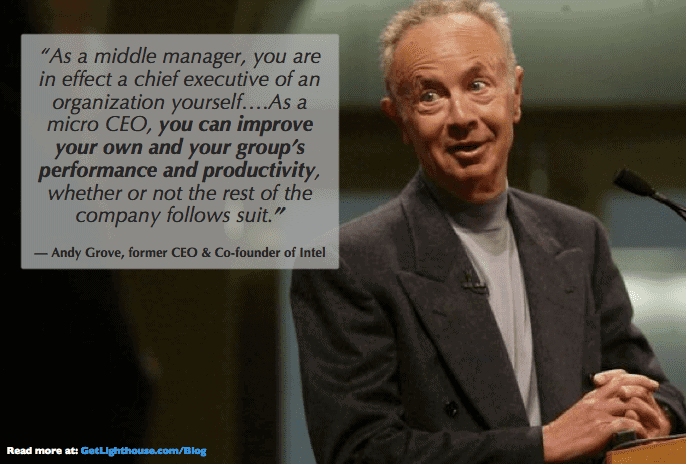
How to Finish an Employee Turnover Wave
One time your employees are leaving, the deck is stacked against you, only information technology's possible to plough the tide. It but takes some hard work and the willingness to focus on your people.
As Jason Lemkin writes, "Once they tell you they have another offering … they're already out the door. " But that doesn't mean you can't salvage the people all the same on your squad, fifty-fifty if you think they might be interviewing.
Here's how you lot can plow the tide and stop a loss of i or ii people from ballooning to much more.
Stopping employee turnover is all well-nigh open up communication and taking activity. If you need assist turning things effectually, sign upwardly for a free trial of Lighthouse and start improving your team'due south situation– and your retention rate– today.

1) Assume everyone is leaving and interviewing.
You lot should talk to everyone on your squad, regardless of whether y'all believe they're planning on leaving or non.
Don't ready the standard that the just way to get attention is if you fright they're interviewing. Everyone on your team deserves the same treatment. After all, they could be adjacent.
Realize also that even those that stick around may only be doing it out of necessity. It could exist due to a:
- Visa or immigration restriction
- Big life event approaching–nuptials, baby, buying a house, etc
- Or waiting on a promotion earlier leaving and then they can get a meliorate title and salary elsewhere.
These employees deserve the same attention and opportunity to assistance brand circumstances better for themselves and their team.
There's also a proficient take a chance that the remainder of the team is not as productive and motivated as they could be during this fourth dimension. Simply considering y'all're staying doesn't hateful you're happy.
Therefore, if you lot fix your work environment's problems, everyone will likely be more than engaged and productive in addition to improving your employee turnover charge per unit.
Takeaway: Don't take anyone for granted. Assume that everyone is because leaving and invest in listening to, and improving things for,anybody on your team.

2) Have that what you're doing now isn't working.
Merely because yous're happy or satisfied doesn't mean everyone else is.
If your employees are leaving, information technology's a huge point fire that at that place are bug to be dealt with. Exist open to their feedback and the issues they bring up (especially if they they're about things you practise).
It may be hard to hear, and the solutions may be hard to implement, but realize that the situation is dire. Ultimately, it's change, or lose them.
Yous demand to accept this earlier you first talking to your employees. Otherwise, yous'll likely find yourself being defensive of anything you lot hear and find it hard to bring about whatever of the change y'all need to.
Only in one case y'all take change must happen can you be gear up to turn the tide on a wave of employee departures.
Takeaway: When multiple team members are leaving, it's a sign that change is needed. Accept that this alter must showtime with you and embrace that mindset.
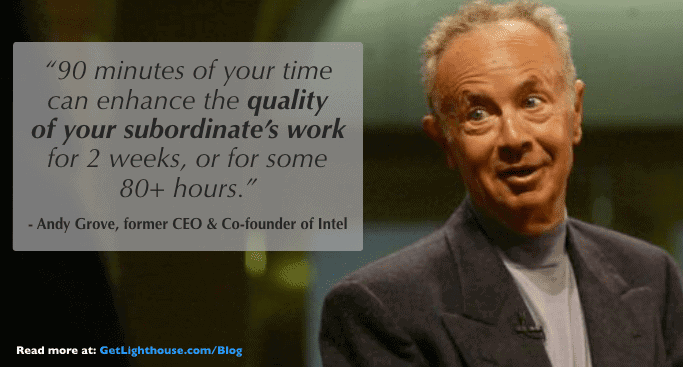
3) Take open, honest, lengthy one-on-ones.
There'due south usually more than one reason why your employees are considering leaving. These issues have likely grown to cause the wave you have at present.
You lot demand to prioritize taking the fourth dimension to listen to your employee's issues and take them seriously. This may slow downwardly some work, but it beats the lost productivity when y'all don't have a team member on staff any more than at all.
To assistance you organize your 1:1s and have everything y'all need in one place, nosotros've prepared a free meeting template you can download below.

These meetings should simply be called i-on-ones, non "rescue meetings," "stay interviews," or "retention efforts". You don't want to imply that the just reason y'all're doing them is because of the threat of people leaving.
And you should continue doing one-on-ones long after this turnover wave is a afar memory to ensure y'all never return to this kind of crisis (don't settle for quarterly check-ins).
While you may be really busy, an investment in regular 1-on-ones will pay y'all back many times over.
Takeaway: Start having i-on-ones with everyone on the team weekly (or biweekly for big teams) and keep having them so problems never overflow again. Lighthouse tin help you do this. Try for complimentary now here.

iv) Listen & testify empathy.
According to Rachel Green, Director at The Emotional Intelligence Plant in Western Australia, defensiveness holds many leaders back. Defensive leaders have a hard fourth dimension albeit they need to make improvements, which makes the build-upwardly of issues inevitable.
Resist the temptation to be defensive. The only fashion obtaining, and acting on, feedback from regular 1 on ones with your team works is if you lot respect their opinions and sympathize that the alternative is losing them altogether.
They may not even trust you plenty to really open on the biggest issues, so do your all-time to understand with their view of the earth; they probable don't have access to the same data you do, nor the same perspective of what'southward going on in the visitor and on the team as yous do.
As Andy Grove writes in High Output Management, managers should apply Grove'due south Principle of Didactic Management:
"Enquire one more question!" When the supervisor thinks the subordinate has said all he wants to about a subject, he should ask some other question.
He should attempt to go on the flow of thoughts coming by prompting the subordinate with queries until both feel satisfied that they accept gotten to the bottom of a problem."
Your job in these meetings is to understand their bug and help create ways to resolve them past listening and asking questions. So work together to make changes based on what you lot learn to improve their piece of work life.
If you're looking for some ideas on the kinds of questions to ask, hither'southward a comprehensive list of 1-on-one questions.
Takeaway: One-on-ones are all about them. Come with questions and an eagerness to sympathize their indicate of view, so y'all tin gear up what'southward causing your employee turnover.
And for more on overcoming defensiveness, read these posts on developing self-awareness to become a improve manager:
- Mindfulness at Work: How Mindfulness Tin can Make Yous a Better Manager
- Leadership Lessons: How to Overcome Your Personal Weaknesses
v) Follow through & take action.
The best way to build trust with employees that might exit is to take activity on the feedback they give yous. Y'all may non be able to gear up all the problems, only even small, incremental progress tin really better employee morale and attitude.
Chances are, in your commencement coming together they won't tell you the deepest, hardest problems bothering them. Instead, y'all'll probable get 1 or 2 smaller things that they volition utilize as a examination as to whether they can trust you, and to run into if anything will modify.
If you do zilch at this bespeak, yous've lost. They'll say to themselves, "James and Susan were correct…null'due south ever going to change effectually hither."
If their honesty is deflected or punished in any fashion, you'll never get any truth from them once more…until their exit interview. However, if you do start showing that progress, you can slowly win them back and go to the bottom of the problems plaguing the squad.
Takeaway: Make certain you take activeness on everything yous can from your discussions. Trust is very fragile at this stage and must be rebuilt over time past making progress on what'due south important to them.

Offset on Day one: Reduce your employee turnover rate by improving your onboarding process
Then far, we've talked about why employees exit in waves. We also talked nigh what to do to manage employee turnover by implementing a organization for obtaining and acting on employee feedback.
All the same, there's something else you can do to reduce your employee turnover rate significantly long before information technology ever becomes a problem. That's by improving your employee onboarding process.

It starts on their first solar day.
According to a report by The Wynhurst Group, new employees are 58% more likely to stay at their employer three years subsequently if they had an constructive onboarding experience.
It'southward no surprise so why companies with effective onboarding also report greater revenue and turn a profit margins:
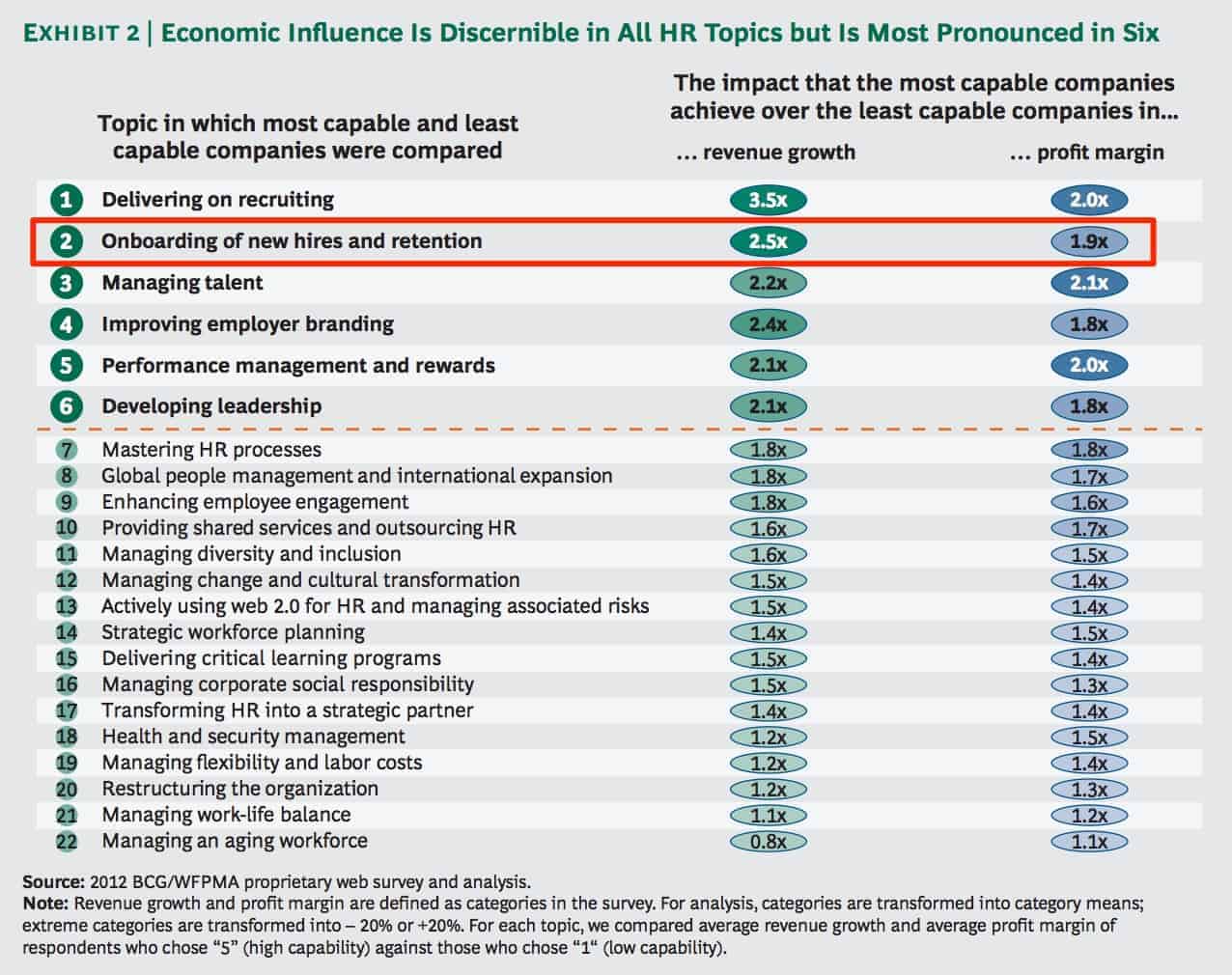
The problem is, according to a study by Gallup, just 12% of employees "strongly agree" their company does a expert chore onboarding new employees. Chances are, you're in the other eighty-eight percent and could use some improvement.
3 Tips for improving your employee onboarding process:
Fortunately, there's a lot you tin can do to improve your onboarding process to help reduce your employee turnover rate. Hither are a few places to get started:
- Write out an onboarding programme: If you don't know exactly how you lot onboard new employees, including a written checklist everyone is familiar with, chances are your onboarding is poor. Showtime by writing out a list of everything that gives your new hires what they need to accept a great first day, calendar week, and month. And then, piece of work to put those pieces in place and iterate.
- Give new employees a buddy: A buddy is a quick and easy style to amend your onboarding procedure. It gives your new employee someone to connect with personally right off the bat. Plus, it's an easy and satisfying role for other team members as a kind of mentor. As a bonus, the new team fellow member knows who they can ask questions of, while saving the remainder of your team from likewise many interruptions.
- Use welcome kits to make new employees experience welcome: A welcome kit is a not bad way of showing your new hire what your company is all about in a overnice, nifty little package. It's a great way of demonstrating your civilization and making them feel, welcomed warmly. Below is 1 that the SalesForce UX team gives to their UX designers:
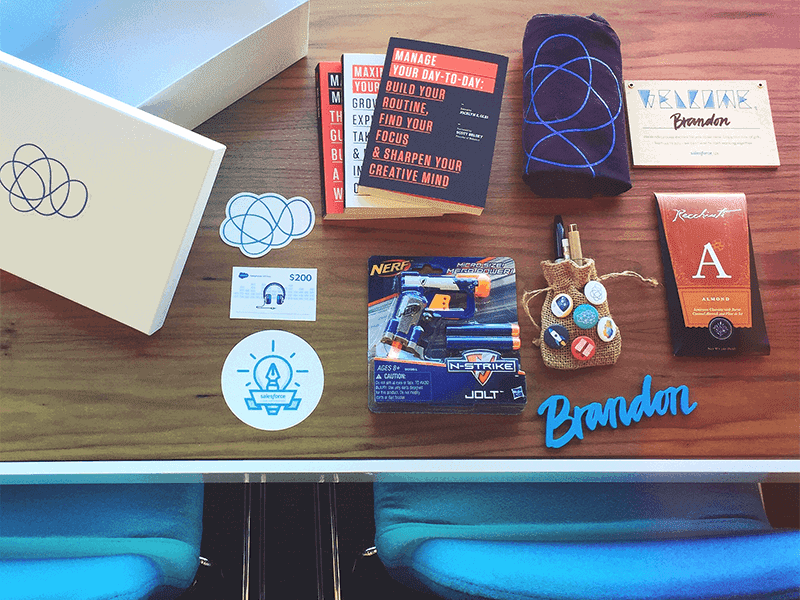
There'due south a lot you tin can practise to ameliorate your employee onboarding procedure (and reduce your employee turnover rate in the process). However y'all do it, ultimately, the point is to:
- Make them feel welcomed and accepted as a person (assistance them connect with other squad members and feel psychological safety)
- And give them everything they need to get off to a fast start (feeling progress in their new part and getting your company productive team members faster)
To acquire more well-nigh improving your visitor'south onboarding process, read How to Improve Your Employee Onboarding Process to Engage Your Hires & Forestall Employee Turnover
Further reading
To learn more about reducing employee turnover and maintaining a happy and productive squad, read:
- Leading Happy Teams: 5 Ways to Keep Your Team Happy in a Recession
- How to Help Your Team Avoid Employee Burnout during COVID
- 13 Reasons Why Bully Employees Quit
- How to Turn Around an Underperforming Employee
- 5 Ways Founders Wreck Their Company Civilisation (and How to Create a Swell Company Culture Instead)
And for more on how to exist a great managing director:
- xxx Ane on Ane Coming together Tips for Effective One on Ones
- vii Tips for First-Time Managers: How to Win as a New Managing director
Desire help fighting employee turnover?
If y'all're working on an employee turnover problem, you lot're probably under a lot of stress and have a lot on your plate. The all-time thing yous can do to assist yourself, and reduce your employee turnover rate, is to be organized, intentional, and diligent in these 1-on-ones.
An app like Lighthouse can help you organize your one-on-ane notes, follow through on what you discuss, manage action items for both of you, and e'er come prepared for the side by side one, all in ane place.
You lot can learn more and sign upwardly for admission at GetLighthouse.com

Take y'all e'er saved someone who was thinking virtually leaving? How did you do it?

Source: https://getlighthouse.com/blog/employee-turnover-why-employees-leave-waves-how-stop/


0 Response to "reddit what to do about co-worker leaving early all the time"
Post a Comment